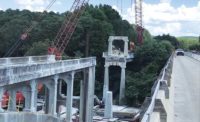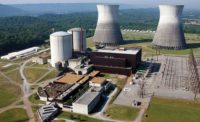To make sure the new steel would connect to the existing framework, connections were designed with slots and seats that provided some flexibility.
“The existing building had lots of different kinds of plating, and all the connections were riveted,” says Larry Kruth, vice president of engineering, technology and safety for Douglas Steel Fabricating Co., Lansing. “We photographed and measured every point where new steel connected to the existing, then made the connections slotted for flexibility in fitting.”
A consulting engineer modeled how many pieces of the existing steel could be removed at a time without affecting the building’s stability.
Just getting the steel and concrete into the work areas was a challenge, Holmstrom says. “Being a power plant, the building wasn’t built with doors on every floor, and it’s 175 ft tall from basement to top,” he adds. “So how do you get the old steel out and the new steel and concrete in safely?”
The answer for getting steel in and out was cutting two 20- by 25-ft hatches in the ninth-floor roof and using lattice-boom crawler cranes to lift components in and out. Spotters on the roof and at the placement point inside the building helped guide the crane operator.
“We started from the bottom and worked our way up,” Holmstrom says. He says the crew would set the steel and decking for half a floor per day. The following day, a concrete crew would pour cement on the half floor that had been placed the previous day, while ironworkers set steel for the other half of the floor.
“Each completed floor acted as a diaphragm that made the building stronger and stronger,” Holmstrom says.
After completing the main building, the construction team built a new four-story addition just to the north of the renovated building and a four-story atrium that connected the two. Both of the new structures were built using standard steel-frame methods.
Other structural work on the site included demolishing a 900-stall concrete parking garage that blocked the building from an adjacent street and then building its 1,000-car replacement at the north end of the headquarters building.
div id="articleExtras"



Post a comment to this article
Report Abusive Comment